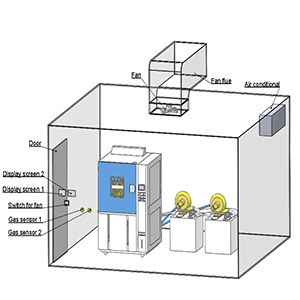
The use of silent discharge ozone generator, automatically produce high purity ozone, precise control.Ozone concentration is 1-1000PPHM.
Corrosive gas test chamber is used to evaluate the protection performance of products in toxic gas environments simulating different toxic gas environmental conditions, such SO2,H2S,NO2,CL2,O3 etc., Corrosive gas test chamber includes SO2 noxious gas test chamber (single gas), mixed flowing gas corrosion test chamber, ozone test chamber. These three test chambers have different structures, but the basic principle is to create a toxic gas environment for the test piece. Corrosive gas test chamber is complying with IEC 60068-2-42 and other relevant standards.
Gas test chamber is used to evaluate the protection performance of products in toxic gas environments simulating different toxic gas environmental conditions, such as ozone, SO2,H2S,NO2,CL2,O3 etc.,






The use of silent discharge ozone generator, automatically produce high purity ozone, precise control.Ozone concentration is 1-1000PPHM.

The ozone exhaust device is equipped with activated carbon to absorb the ozone gas after the test, so that the workplace is clean and safe. This process is automatically controlled by the controller.

The workroom's stainless steel material is covered with a layer of glass steel, which both prevents corrosion and enhances the robustness of the equipment.

Equipped with a NAOH solution tank for diluting SO2, making the workplace clean and safe.

The noxious gas corrosion test chamber can perform single gas test in accordance with IEC 60068-2-42, IEC 60068-2-60 and other standards, and can also perform NO2, CO2, H2S and SO2 mixed gas test.

Advanced PID control system, 12 languages are available.LCD displays test conditions (including temperature, humidity, gas concentration, etc.).
Corrosive gas test chamber, a type of environmental test chamber for sale at LIB Industry, can accurately control the concentration, composition and mixing ratio of specific toxic gases such as SO2,H2S,NO2,CL2 and etc. Temperature and humidity conditions in the corrosive gas test chamber can be set and maintained to simulate the impact of toxic gases on the test pieces in different climates more comprehensively.
Corrosive gas test chamber tests and evaluates products, to observe whether there is performance degradation, damage, failure, etc., in order to judge its tolerance to toxic gases.
1. Based on the test standards and sample to be tested, and determine the required corrosive gas type, concentration range, environmental parameters. LIB Industry corrosive gas test chamber’s single gas and combined gas can be SO2, HCL, H2S, CO2, NO2 and CL2.
2. Select chamber with high-precision sensors and control systems to ensure the reliability of experimental data. LIB corrosive gas test chamber is equipped SO2 sensor, SO2 gas concentration detection transmitter. The gas concentration is valued by PPM, control accuracy: ± 0.1% FS and sensor with calibration (Zero adjustment in a 99.99% nitrogen environment, stay in 15mins).
3. LIB Industry corrosive gas test chamber with safety protection measures, such as good sealing of the work room and safe treatment of toxic gas after the test.
When maintaining the corrosive gas test chamber, follow the relevant safety regulations, wear appropriate protective equipment, and ensure that the toxic gas in the test chamber has been completely removed before maintenance.
1. Clean regularly: Internal cleaning: Wipe the inside of the corrosive gas test chamber with a soft, damp cloth to remove dust, dirt and residual chemicals. Be careful not to use cleaners that may cause static electricity or corrosion. External cleaning: Wipe the shell to keep the appearance clean and easy to observe the device status.
2. Check the gas pipes: Regularly check whether the connection of the gas pipeline is tight in a corrosive gas test chamber, whether there is loosening or leakage. Check whether the pipes are damaged by aging or cracks, and replace them in time if necessary.
3. Gas exhaust device maintenance: Gas intake inspection: clean or replace the air intake hose regularly to prevent impurities from entering the corrosive gas test chamber and affecting the gas quality and equipment operation.
4. Check the seals: Check the seal between the corrosive gas test chamber door and the corrosive gas test chamber to ensure that its sealing performance is good to prevent toxic gas leakage.If there are aging or damaged seals, timely replacement.
The Canadian Standards Association (CSA) was established in 1919 to establish rules in industry and to develop voluntary standards for the electrical field. CSA's standards for safety certification apply to a wide variety of electrical equipment, from industrial and commercial equipment to household appliances.
In June 2023, CSA Group sent an email to LIB stating that they needed to conduct corrosion resistance testing of arc fault detection device under UL 1699B,and give the detailed technical requirements:The temperature and humidity value,Hydrogen sulfide, nitrogen dioxide mixture and workroom size.
LIB designed the corrosive gas test chamber according to the parameters they needed, and quickly went into production. In June 2023, the customer receives the product.



